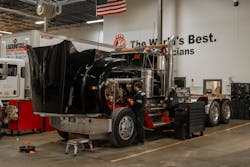According to its director of service operations, J. Ellis, the Kenworth Northeast dealership has seen an increase in vehicles coming in for major repairs like engine rebuilds and transmission replacements, especially from the vocational side.
“We’ve been seeing quite a few invoices well over $50,000 lately,” Ellis revealed.
This isn’t just happening at Kenworth Northeast, an independently-owned truck dealership with eight locations in New York, Massachusetts, and Rhode Island. Fleets trying to hold on to aging assets seems to be a nationwide trend, according to the data.
An August 2022 study published by the American Transportation Research Institute (ATRI) found the average trade cycle on a tractor-tractor has increased to 8.7 years.
“There appear to be a couple of reasons for this,” ATRI’s SVP Dan Murray said. “First, equipment costs have gone through the roof in the past couple of years. Secondly, supply chain issues have made trucks and many components not only really expensive but oftentimes quite rare.”
The high costs can still be preferable to current higher interest rates. These add to the ownership cost equation, particularly with smaller to mid-size fleets that typically don’t purchase new equipment with cash.
“It’s really a perfect storm right now,” Murray said of the financial situation.
There’s no telling when the economics will get easier, so for now, fleets have scrambled to turn back the clock, or odometer (hypothetically speaking), trying to squeeze out a few more years of reliable service. That’s easier said than done, as there’s no quick fix, no literal Fountain of Youth to douse your assets in. (Sorry for the misdirect.) But with plenty of sweat, a team of dedicated maintenance folks, a solid strategy, and proper execution, at least some of those hard miles will wash away. And you’ll have a reliable asset until you’re ready to sell.
See also: The post-pandemic parts plan: Distributor and supplier solutions
Time to ramp up the PMs
When developing a maintenance strategy for an older truck, the first thing to do is assess how well the vehicle has been taken care of earlier.
“If the truck has been getting good preventative maintenance that’s up to manufacturer recommendations, there might not be a whole lot that has to change,” said Dan Nynas, COO of Diesel Laptops, a provider of diagnostic tools, repair information, and technician training.
That’s a big if, though. Nynas said many fleets have grown accustomed to a four-year trade cycle before the pandemic. Given that, although it’s never recommended, preventive maintenance often wasn’t up to OEM recommendations because a fleet knew it would be getting rid of a truck before it started to show its wear and tear. If a fleet is now hanging on to trucks for more than five years, it could all come back to bite them.
“It’s quite possible things like overhead valve adjustments were skipped,” Nynas said. “Sometimes fleets try to extend out drain intervals a bit too far, or maybe skimp on fuel filters. If a fleet now decides to stretch that trade cycle, these are the types of things they need to focus on getting right. These types of simple actions could help extend the life of things like fuel injectors and fuel pumps. But if these steps have been ignored for the first four years of service, the damage may have already been done.”
So, then what?
Drivers and technicians should be on the lookout for even the smallest of oil leaks.
“Even something like a front cover that’s starting to get wet must be reported,” said Jeff Celantano, technical data manager at Diesel Laptops. “It might not create a problem right then and there, but it will likely turn into a problem when you least expect it. The same can be said for hydraulic oils and engine coolant.”
See also: Five topics to explore with contract maintenance providers
Discoloration in the oil is another indication of real trouble.
“If they aren’t doing it already, we always encourage our customers to start doing oil analysis once a vehicle is over 500,000 miles,” Kenworth Northeast’s Ellis said. “Even just doing it every other oil change or even once a year can be beneficial.”
Tech training is also crucial. Oil samples must be captured midstream and properly labeled. The fleet must also partner with a good lab so analysis is reliable and consistent. “Oil sampling can be a great tool, but only if it is done correctly,” Nynas said.
In addition to engine oil, it can be beneficial to take samples from the transmission and drive axles. “This can give fleets a good look at the health of the assembly, as well as what’s going on in places that are not visible,” said Anthony Balkonis, VP of services and warranty at Navistar.
More thorough electrical inspections also become essential as vehicles age, particularly vehicles that were somewhat neglected during their earlier years. Technicians should look at wiring harnesses and harness connectors for things like chafing.
Paying particular attention to the electrical system is even more critical if the vehicle has been operated in a more punishing environment.
“If the unit was operated in Rust Belt areas, it is common to begin seeing the effects of climate and road conditions on the electrical system, primarily grounds,” said Andrew Plant, manager of powertrain service engineering at Daimler Truck North America. “Maintaining a good electrical system, including batteries, cables, and grounds, is critical to proper electronic engine controls.”
The half-million-mile hurdle
In addition to ramping up PMs, there’s a good chance fleets will also start running into a new batch of service items at half a million miles.
“Most OEMs have maintenance guidelines well beyond when the first owner normally keeps the truck,” Balkonis said. “If a fleet has developed its own maintenance checklist based on a shorter lifecycle, it is important to update the inspection form to include the OEM’s recommendations out to their extended lifecycle. Components they would not have needed to inspect when trading a truck at their prior lifecycle may now need to be serviced or replaced.”
For instance, Balkonis said looking at things like suspension bushings, A-cams, harnesses, and cable routing is important. S-cams and tubes are another overlooked area. “S-cams are rarely removed unless they are frozen. But as a vehicle ages, bushings can wear out. Catching that quickly helps keep the unit on the road and prevents a major brake assembly overhaul,” Balkonis said.
Braking system inspections should also include a couple of additional steps.
“I’d be looking at brake hoses,” Celentano said. “The plastic ones tend to dry out and sometimes split at the crimp.”
See also: Old and New School ways needed for tech recruiting, training
O-rings are also at the top of the list, according to Nynas.
“Over time, after exposure to detergents in the oil, O-rings start to get hard and brittle and shrink,” Nynas said. “You might start experiencing some leakage. But the bigger issues are inside the engine—things like oil pickup tubes and suction manifolds.”
As Nynas explained, degraded O-rings start to allow air contamination in the lubrication system. That becomes a ticking time bomb in a vehicle with more than half a million miles on it. “This is what can lead to things like bearing failure,” Nynas pointed out. “It’s a good idea to simply replace the O-rings and seals in a lubrication system at this point.”
Air dryers should also be thoroughly examined, and we’re not just talking about the desiccant cartridge. The entire module should be inspected. An air dryer also has a valve and most have heaters. “These things are typically about shot by this point,” Nynas said. “Simply getting them replaced is probably a good idea.”
Turbocharger issues also tend to plague heavier-duty trucks—especially the ones that have quite a bit of time under their belts.
“Oil breaks down,” said Josh Steinmetz, brand manager at Lubrication Specialties, a provider of oil, lubricants, and additives whose brand names include Hot Shot’s Secret. “At the end of a long day, that oil is really hot. The bearings on a turbo are extremely hot. If you don’t let that oil cool down and cycle through, it actually burns right onto the turbo bearings. That can cause a lot of issues over time. You might even see bearing failure.”
In a case like this, a technician may need to rely on driver input because visual indicators won’t be noticed, short of tearing down the entire turbo. “Ask drivers if they are experiencing any kind of loss of power or other issues,” Steinmetz said. “If they are, that’s a good time to start using some additives before the issues get any worse.”
One option, Stiction Eliminator from Hot Shot’s Secret, is a blend of synthetic cleaner and proprietary lubricant that can be used in oil systems. “Stiction Eliminator can help clean up that burnt varnish that tends to accumulate on a turbo bearing,” Steinmetz explained. “It doesn’t just clean it up, either. It also has our FR3 technology that helps fortify the oil, helping prevent it from burning so easily in the first place.”
This article originally appeared on Fleet Maintenance, a sister site of FleetOwner.





